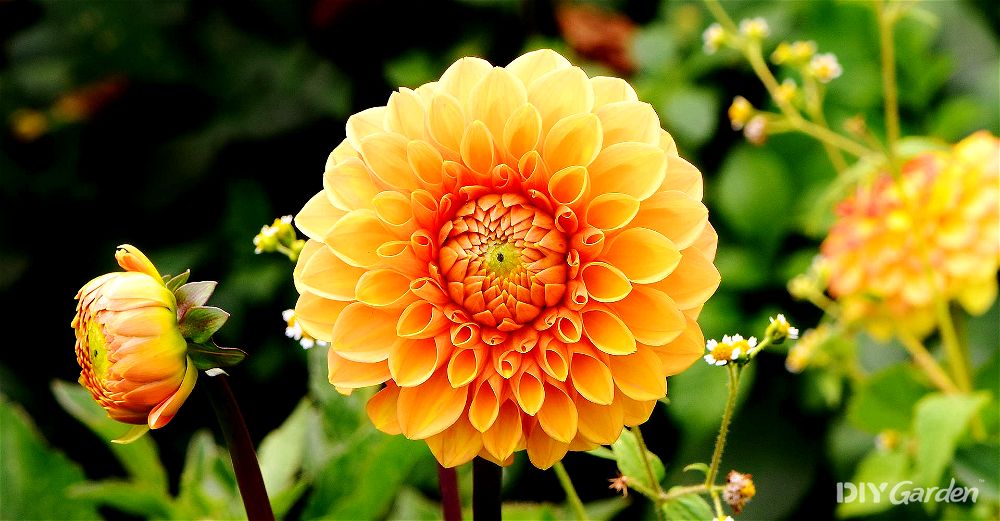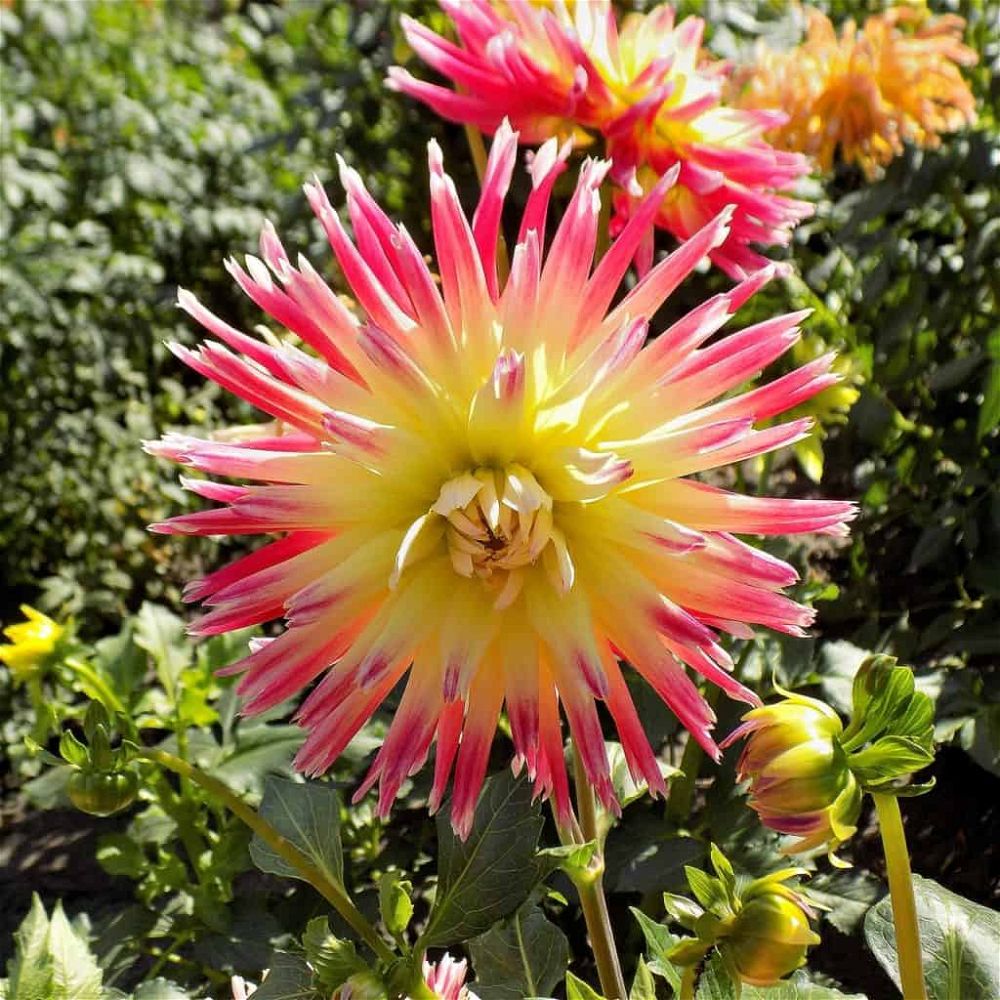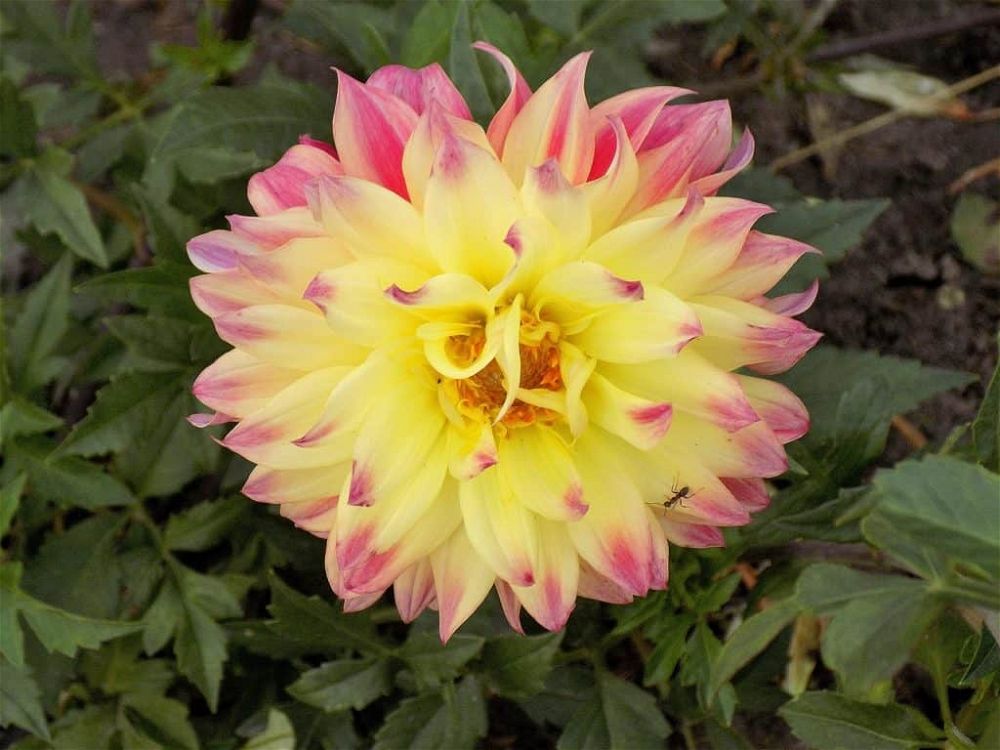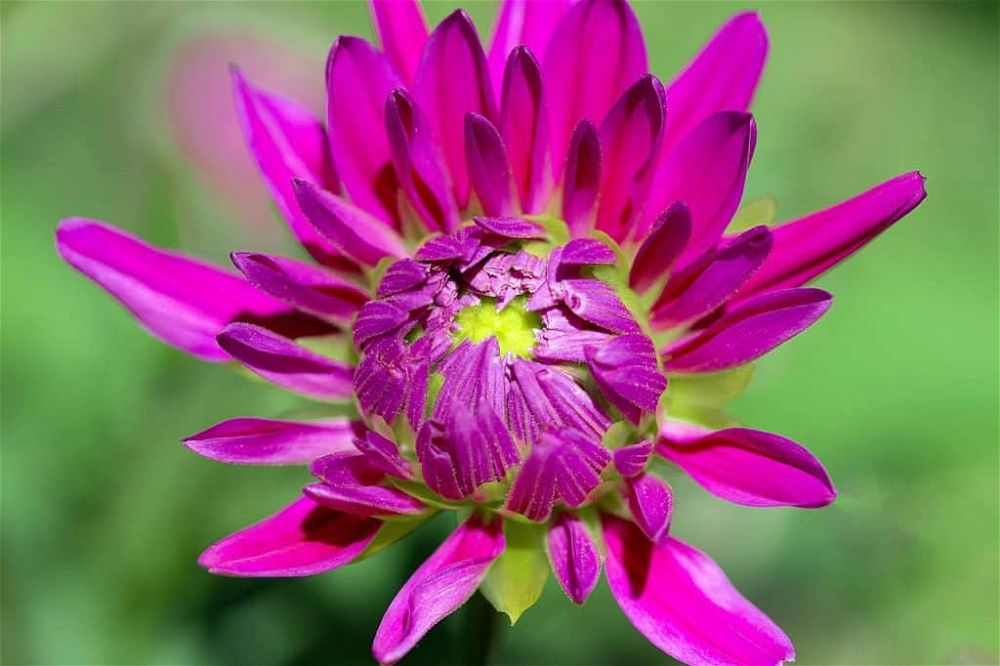
Jump to a Section
Plant Overview
| Common Name | Dahlia |
|---|---|
| Scientific Name | Dahlia hortensis, D. pinnata, D. rosea, D. coccinea, D. varabilis |
| Plant Family | Asteracea |
| Origin | Mexico and other parts of South America |
| Height | 15cm to 2m |
| Light | Full sun |
| Temperature | Plant in a warm position in the garden |
| Hardiness | Tender |
| Soil | Well drained soil with lots of organic matter |
| Fertiliser | Keep well supplied with a potash-rich fertiliser. |
| Propagation | Cuttings |
| Pests | Slugs and snails, aphids, red spider mite, earwigs |
| Difficulty | Moderate |
The dahlia was first brought to Europe from Aztec Mexico by the Spanish in 1789, not for the beauty of its flowers, but as a potential new food plant. While the tubers never did make it to the Sunday dinner table, keen gardeners saw opportunities in the 2m high plant with rather boring yellow flowers.
By the mid 1800s, the dahlia was well underway on its journey of selection and hybridisation to where it is today, with a bewildering array of different varieties in almost every shape, size and colour imaginable.
As with all fashions, the popularity of dahlias has come and gone over the years, and from being a must-have plant for fashionable gardens, there have been times when it has been regarded as too garish and overpowering for more subtle garden designs. However, there can be little doubt that dahlias offer brilliant colour if planted selectively in an appropriate context in the garden, and the thousands of varieties that are available from garden centres and nurseries bear testament to their enduring popularity. Possibly unrivalled as cut flowers, dahlia plants will soon replace any blooms taken for the vase.
This article looks at some of the most popular varieties and explains how to care for this tender beauty in the garden.
Dahlia Care
Although generally grown in the UK as annuals, dahlias are actually tender perennials. While it is possible to overwinter them in a frost-free place, most gardeners buy new tubers each spring and treat them as annual bedding plants.
If bought early, the tubers can be started indoors or under glass in pots in March, and are ready for hardening off and planting out in June. Alternatively, the tubers can simply be planted out into the border in the early summer once all danger of frost has passed.
Plant the tubers horizontally, making sure the ‘eyes’ or growing points are uppermost, at a depth of approximately 12cm. Unlike potatoes which have eyes all over, dahlia tuber eyes are restricted to the end where the plant stem emerges. After planting, mulch the bed to keep the weeds down, and keep the soil well watered. The plants will reward careful preparation with repeat blooms from July right through to the first autumn frost.
Some of the taller varieties with the biggest, heaviest blooms will need support to keep them upright. Use three canes in a triangle around the plant and provide support with successive loops of garden twine around these canes as the plant grows taller.
Light requirements
Dahlias do best in open border positions where they will get full sun and good ventilation.
Watering
Keep the ground where the tubers have been planted moist, and water the young plants frequently for the first half of the summer as they are growing, though ensure good drainage and never allow the ground to get water-logged. Once established, the long roots and tubers will supply the plant with water but they will still need topping up in dry weather.
Soil conditions
Although dahlias will grow in most types of soil, they thrive best in rich soil with good drainage. A sandy soil that has had repeated applications of organic matter such as garden compost or well-rotted manure is ideal.
Fertilisers
Incorporate an organic fertiliser such as bone meal or fish blood and bone into the soil a few weeks prior to planting. A couple of good handfuls to the square metre is an ideal rate.
To promote repeat flowering, the plants can be fertilised in late summer with a home-made comfrey feed or a proprietary potash-rich plant food such as liquid tomato feed.
Pruning
The plants will not require pruning but repeat flowering can be encouraged by removing flowers that are past their best. At the peak of the flowering season a bed of dahlias should be dead-headed every couple of days.
Dahlias typically produce a main flower bud and two smaller flower buds at each growing point. The main flower will generally develop into a larger bloom if the two side buds are removed. This is probably not worth doing for all of the dahlias in the garden border, but it can help to produce choice blooms from selected plants for the vase or for exhibition purposes.
Dahlia Propagation
It can be expensive to buy a lot of new tubers each year, and it is relatively easy to grow new plants from cuttings if the dahlia tuber can be tricked into making new shoots in late winter. Take the tubers out of their storage bag or net, and place them on a shallow layer of damp, general purpose compost in the bottom of a seed tray. Cover them with more of the compost, leaving just the stumps of the previous year’s stems showing. Put the tray on a windowsill or unheated greenhouse bench and vigorous shoots will spring up from the tuber within a couple of weeks.
Select strong, healthy shoots about 7cm long and remove them with a small piece of the tuber using a clean knife. Remove the lower leaves flush with the stem, and trim the base of the cutting to remove any untidy plant tissue that could lead to rot. Dip each cutting into hormone rooting powder and insert three cuttings, 2.5cm deep, into a 10cm pot of John Innes No.1 or good quality cutting compost. Place the pot and cuttings in a propagator or place a supported clear plastic bag over the pot and secure with twine.
After three to four weeks the cuttings should have made good roots, so they can be carefully removed from the pot and transferred into individual 7.5cm pots of a good general purpose peat-free compost. If they are well watered and fed weekly with a high-potash fertiliser, they will be ready to harden off and plant out after the last frosts. They will generally flower in the first year.
Common Dahlia Problems
Healthy dahlias will generally be vigorous enough to withstand most pests and diseases, especially if they are grown as annuals.
Pests
Slugs and snails can be a problem, especially for the darker-leaved dahlias, and they are most susceptible as young plants when only recently planted out. Some protection will be necessary in slug-prone gardens, at least until the plants are well-established.
Tattered petals may also be a sign of earwig infestation. Dahlia enthusiasts generally deal with the problem by placing an inverted flower pot packed with straw on to the top of a supporting cane. The earwigs are attracted to this as a refuge in daytime, and they can then be easily retrieved.
Red spider mites can spoil the look of the flowers and leaves, but they are generally not a serious problem for the plant.
Diseases
Shrivelled flowers with a fluffy white mould are suffering from Botrytis, and dahlias can be susceptible to a range of other fungal infections, especially if they are cramped or have insufficient air circulation in damp conditions. Smut can cause pale spots on the leaves, while powdery mildew leaves a white dusty coating on the upper surface.
Aphids can leave sticky patches on the plant and reduce its vitality, and most seriously they can spread diseases such as mosaic virus that causes the leaves to become crumpled and develop spreading mottled, pale yellow patterns that eventually lead to leaf loss.
Any fungal or virus infected material should be removed and burned as soon as it is noticed, and good garden hygiene adopted to ensure that the infection is not spreading to other plants. In good growing conditions, plants that are helped in this way will generally grow away from the problem over the rest of the season.
Aphids and other pests can be sprayed, though many gardeners prefer to rely on organic methods to keep them under control.
Dahlia Varieties
There are literally thousands of varieties of dahlia. One estimate suggests that 60,000 cultivars have been developed from the original 30 species. They are classified into 18 types that range from 2m high giants with 20cm diameter flowers down to dwarf varieties that are only 15cm tall. With such variation in habit, careful cultivar selection is needed to ensure that the colour, shape and size are appropriate for the chosen location.
Some varieties have been developed for their almost black foliage, while just about every flower colour imaginable is available, except for the elusive blue dahlia. Some of the favourite types and varieties are listed below.
Single dahlias have daisy-like blooms with a single outer ring of florets, which may overlap, around a central disc.
Dahlia ‘Happy Single Wink’ has lilac-pink flowers that really glow in the sunshine. It has the RHS Award of Garden Merit.
Dahlia ‘Moonfire’ grows up to 70cm tall, has dark green foliage flushed with purple, and bears masses of bright yellowy-orange flowers with a band of brilliant orange around their centre.
Anemone-flowered dahlias have powder-puff flowers with one or more outer rings of flattened ray florets surrounding a dense group of tubular florets, with no obvious disc.
Dahlia ‘Boogie Woogie’ has a skirt of two outer layers of pink-tinged mauve petals surrounding a tighter orangey-yellow ball in the centre.
Dahlia ‘Floorinoor’ grows to 1.2m tall and has striking, almost luminescent pink flowers with a bright orange centre.
Collarette dahlias have blooms with a single ring of normally flat, overlapping ray florets, and a ring of small florets (the collar) and a central disc.
Dahlia ‘Twyning’s White Chocolate’ has a pure white collar and petals around a bright yellow disc, offering a mass of repeat blooms that are a little subtler than many other dahlias. Try it with the contrasting velvety purple-red and deep pink Dahlia ‘Night Butterfly’ for a classy display.
Waterlily dahlias have double flowers of broad, slightly wavy ray florets that create a saucer-shaped appearance. They are fairly recent addition to the range of types available, and add a touch of Monet to the herbaceous border.
Dahlia ‘Water Lily White’ has pink-tinged white flowers, while the flowers of Dahlia ‘Water Lily Yellow’ do a very good impression of our native yellow water lily.
Decorative dahlias have double blooms with no apparent disc. The ray florets are generally broad and bluntly pointed, and they can be flat or slightly twisted.
The archetypal Dahlia ‘Contraste’ has been around since the late 1950s and its showy 20cm purple and white flowers are as popular as ever.
By contrast, Dahlia ‘Café au Lait’ has flowers that are pure white when they open, but develop tinges of coffee-colour on the petals as they age. It makes a great cut flower and it has become a favourite for wedding bouquets and formal floral decorations.
Ball dahlias have ball-shaped or slightly flattened round flower-heads. The ray florets are rounded at the tips.
Dahlia ‘Maroon Fox’ has dazzling dark purple flowers on a 1.2m high plant, while Dahlia ‘Zundert Mystery Fox’ has dense, ball-like scarlet to orange flowers.
Pompon dahlias have double, miniature, ball-shaped blooms.
Dahlia ‘Golden Sceptre’ is just a metre tall and bears masses of perfect, round pompon flowers with bright yellow petals set in a honeycomb design.
At the other end of the colour spectrum, the otherwise quite similar Dahlia ‘Tam Tam’ has slightly larger burgundy coloured flowers.
Cactus dahlias have double blooms with pointed ray florets that can be straight or incurving.
Dahlia ‘Bora Bora’ lives up to its South Pacific island name with its firework-like crimson and orange 20cm flowers with curving florets. It sits well with the 90cm tall Dahlia ‘Mercator’, which has similar shaped and sized flowers, but these are pale yellow with red streaks that make it look a little like a cheerful bunch of candy canes.
Star dahlias have flowers with a single outer ring of florets surrounding a disc.
Dahlia ‘Windmill’ grows to 1m tall and has bold and cheerful blooms of red and white striped petals around an orange disc, doing a very good impression of a child’s toy windmill.
Dahlia ‘Honka Black’ is only 70cm tall, but its unusual very dark red, almost black, petals that contrast with the yellow centre make up for any lack of stature, giving the appearance of a constellation of stars in the flower border as dusk approaches.
Paeony dahlias have multiple outer rings of flat ray florets surrounding a disc.
Dahlia ‘Bishop of Llandaff’ is possibly one of the most popular dahlia varieties. It has very dark green, almost black, foliage, and dark red flowers with a central ring of golden yellow petals, and looks striking as a mass planting in larger gardens. It is a firm favourite at many National Trust properties and other formal country estate gardens.
The other bishop, Dahlia ‘Bishop of Dover’ is white-flowered, tinged with pink, but has similar dark foliage.
FAQs
Although many gardeners treat dahlias as annuals, they are actually tender perennials and it is possible to save particularly nice or unusual specimens over winter. Many tubers will survive in the ground in the south of the UK if the winter is mild and the soil is kept dry and protected with a straw mulch. But for safety, the tubers (or at least a proportion of them) should be lifted for the winter.
If there is a danger of frosts coming, cut the plant back to 30cm above the ground and carefully dig up the tubers with a fork. Wash off the soil and dry them for a few hours on newspaper. Carefully check for any rot or damage and do not keep any affected tubers. Prune the remaining stems back to the tubers, label, and place in mesh bags (like those that oranges are sold in) or paper sacks. Store them through the winter as you would potatoes, in a frost-free but cool, dry, dark shed or outhouse. You can then replant the tubers in the garden in the following spring when all danger of frost is past.
If you plan to repeat the exercise each winter, it may be easier to put the tubers into large pots that are then sunk into the border or kept on the patio – the whole pot can be retrieved and kept overwinter in a cool, dry place.
Yes dahlias will do fine in a suitable container. Choose a pot that is large enough to allow the tuber to fit comfortably when laid horizontally in the bottom. Add plenty of drainage crocks to reduce the risk of water-logging and rot, and use a potting compost and perlite mix. Plant the tuber flat with the eye facing upwards, with sufficient space to bury it 10cm down. The smaller varieties are the best choice for pots, otherwise some careful support will be necessary and the pot can become top-heavy.




Share